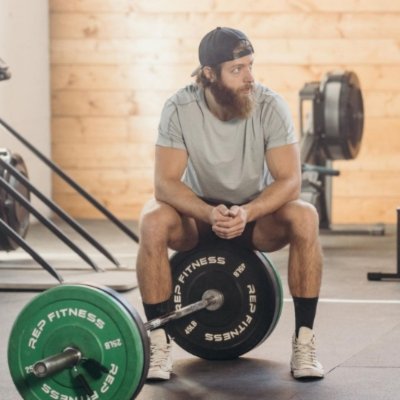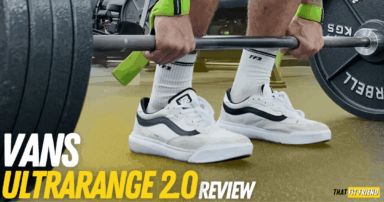The dumbbell bench press is one of the most popular exercises for building pressing strength and building mass on your pecs. This is why it’s an exercise that pretty much every lifter and athlete performs at all skill levels.
If you’re on the quest of building your pecs, then getting good at the dumbbell bench press is a good idea. As you get more specific with your dumbbell bench press goals, you’ll want to make sure you’re not making mistakes that take away from your gains.
If you’re new to the dumbbell bench press, then I’d highly suggest using tempo to thoroughly learn this exercise. Plus, tempo can be a powerful tool for self coaching you away from dumbbell bench press mistakes.
Mistake 1: Flaring the Elbows Too Much
The first and most common mistake that I see lifters make with the dumbbell bench press is flaring the elbows. Let’s be honest, I think we can all admit that we’ve done this as dumbbell bench press beginners.
While flaring the elbows isn’t necessarily an instantly bad thing in the dumbbell bench press it can take away from pec gains and lead to some shoulder discomfort for some — depending on the degree of the elbow flare and intensity used.
Why This Can Be Problematic
Generally speaking, I’ll explain to clients that there are two reasons why we want to avoid flaring the elbows excessively when dumbbell bench pressing.
- More Anterior Delts Than Pecs: The first reason flared elbows can be problematic is that we’ll shift our loading and focus to the anterior delts over the pecs. If your goal is building the pecs, then flaring the elbows will lead to sub-par gains.
- Potential for Shoulder Discomfort: While flared elbows don’t instantly lead to shoulder issues, they can put excessive stress on the shoulder joint over time. I regularly see this with new clients with prior shoulder injuries or mobility limitations.
Coaching Note: There is a world where flaring the elbows may actually be useful if your goal is getting a little more anterior delt in your horizontal press, but for most using the dumbbell bench press for pecs, it’s an inefficient way to grow.
How To Fix This
When we think about training the pecs, it can be useful to remember that there are three major divisions of pec major fibers and these include the:
- Clavicular Pec Fibers: The pec major fibers that come off of the clavicle and connect to the humorous.
- Sternal Pec Fibers: The pec major fibers that stem from the sternum and connect to the humorous.
- Costal Pec Fibers: The pec major fibers that come off of the intercostals and connect to the humorous.
In most cases, I find that lifters and clients want to use the dumbbell bench press to build the “meatier” part of the pec major, and to do this, we’ll want to train and hammer the sternal pec fibers.
To do this with the dumbbell bench press, you’ll want to keep your elbows a little more tucked as this will more efficiently place load and stress on these pec fibers throughout the eccentric (lowering) portion of the exercise and the concentric (pressing) portion.
It’s in this context where flaring the elbows can be a mistake as you’ll be taking away work from the pec fibers you’re trying to build. When dumbbell bench pressing, think about keeping the elbows at around a 45 to 60-degree angle.
As you dumbbell bench press more, I’d encourage you to play with different elbow positions over the course of multiple weeks to see what you respond best with. Your anatomy can play a role in which angle will be best for building your pecs efficiently.
Mistake 2: Pressing Out and Away
Another mistake that I see lifters make with the dumbbell bench press revolves around efficiency and wasting energy and that’s pressing the dumbbell out and away each rep.
To be fair, this is a pressing mistake that can transcend dumbbells and should be avoided when doing all forms of horizontal pressing. Inefficient movement patterns can severely reduce gains when exercising for strength and hypertrophy.
Why This Can Be Problematic
The act of pressing dumbbells out and away entails pressing in a pattern that takes away from your ability to stack the joints. For this mistake, lifters will either press their dumbbells too far forward or backward.
To picture this, hold your arms straight out in from of you in a straight line, then bring them down or up slightly, and notice how all of a sudden your delts are working harder to maintain this position.
When you’re dumbbell bench pressing this same concept applies and if your goal is moving weight or building the pecs, then you don’t want to shift your focus from the pecs, especially in between reps because this cuts into the total effort and output you can put into sets.
How To Fix This
If you’re unsure about your dumbbell bench press path, I’d encourage you to video a moderate to high effort set from the side. You’ll want to video from the side so you can watch the dumbbells, your hand, wrist, elbow, and shoulder.
As you lower the dumbbells and press them back up you want to see your lockout resulting in a relatively straight arm position so your hands, elbows, and shoulders are stacked.
A stacked and aligned pressing path will better advantage your pecs, triceps, and delts to do their jobs and you’ll avoid wasting energy at lockout trying to pull the dumbbells back to a strong starting position.
On top of this, when you’re stacked at lockout your muscles can conserve energy which is great for ensuring you’re able to put the most amount of effort into the eccentric and concentric ranges of motion which is when you’ll make the most gains.
Mistake 3: Lacking a Goal With Your Sets
Another underappreciated mistake is entering your workouts without goals for your dumbbell bench press. I see this all the time with newer lifters, and it’s like they’re going through the motions with their sets.
This is not to say that it’s wrong to go and get a workout in without being hyper-specific, but I think it is advantageous to have intent and effort behind your sets for each workout. And no, this doesn’t mean you need to max out and go 10/10 every session.
Why This Can Be Problematic
More than like you’re programming dumbbell bench presses for a reason. That reason could be general strength, top-end strength, hypertrophy, or even just general well-being and joint health.
Regardless of your goal(s), your dumbbell bench press programming and execution should reflect that. Otherwise, you’re producing effort but potentially leaving gains on the table solely due to not strategizing a little more.
How To Fix This
The easiest way to remedy a lack of direction with your training is to create a list and hierarchy of your goals. Once you’ve plotted the “why” behind your wanting to train, and more specifically dumbbell bench press, you can then build a program and timeline that reflects that.
For example, one of my personal goals right now is improving my pecs’ size and conserving and building general strength. My next weeks of programming look like the following to keep effort and intent high.
- Week 1: 5 sets x 7 reps with an ascending load. Start at 3-4 RIR and work up to a top 0-1 RIR set.
- Week 2: 5 sets x 7 reps with an ascending load. Start at 3-4 RIR and work up to a top 0-1 RIR set.
- Week 3: 5 sets x 6 reps with an ascending load. Start at 3-4 RIR and work up to a top 0-1 RIR set.
- Week 4: 4 sets x 6 reps with an ascending load. Start at 3-4 RIR and work up to a top 0-1 RIR set.
- Week 5: 4 sets x 5 reps with an ascending load. Start at 3-4 RIR and work up to a top 0-1 RIR set.
- Week 6: 4 sets x 4 reps with an ascending load. Start at 3-4 RIR and work up to a top 0-1 RIR set.
- After my 4 x 4 on this day, I’ll drop the load and do 2 x 15 at 0-1 RIR to chase a pump.
This is only one example of how you could structure your dumbbell bench press programming based on your goals. The 6-week flow above is designed to blend my strength and hypertrophy focuses with the dumbbell bench press.
I’ll also have accessories that piggyback off my goals and the programming of this exercise so I can ensure I’m hitting and training my pecs in their entirety. If the above is overwhelming for you, then I’d highly suggest hiring and working with a coach.
Mistake 4: Clinking the Dumbbells At the Top
The fourth and final dumbbell bench press mistake is arguably the easiest to fix and simply not do, and that’s clinking the dumbbells together when you’re locking out reps.
Look, I get it, the sound of the clink is satisfying and there is also a nice feeling of “completion” when you clink the dumbbells together. However, if you’re doing this, especially at higher intensities you’re likely sabotaging your gains.
Why This Can Be Problematic
When you clink your dumbbells at lockout, it’s hard to know how they’re going to respond. For example, a light clink with 100 dumbbells can produce more force than clinking 30 lb bells together. Plus, metal versus rubber dumbbells can also factor in here.
The clink and force that then follows can very easily throw off your mechanics and the stability that you just worked to create at lockout. Nothing is worse than going for 5 reps and having to stop a rep short because you had to re-adjust and waste energy re-stabilizing.
How To Fix This
Stop. Seriously, just stop clinking your dumbbells at lockout. If you’re finding it tough to lock out and not clink the dumbbell try turning your hands slightly as you get closer to your final locked-out position. This will not take away from your gains.
Frequently Asked Questions (FAQ)
Q:Are dumbbells as effective as bench press?
Q:How much should my dumbbell bench press be?
Q:Is dumbell Press harder than bench press?
Q:What are the pros and cons of dumbbell bench press?
Takeaway Thoughts
The dumbbell bench press is an awesome bench press variation for improving strength, mass, and even power. However, to improve all of these you’ll want to make sure you’re strategic and efficient with your dumbbell bench press.
If you’re rushing reps, clinking your dumbbells, or flaring the elbows, then you might be leaving gains on the table with the dumbbell bench press.
If you have additional questions about the dumbbell bench press mistakes discussed in this article, drop a comment below or reach out to me via Instagram (@jake_boly or @that_fit_friend).

















Add a Comment